This book provides a brief story of how railways in East London developed from 1969 to the present day, often with their ownership transferring between National Rail and Transport for London.
Published by Amberley Publishing in December 2020 and written by Malcolm Batten, this softcover book comes in the usual Amberley format of around 234 mm x 165 mm with 96 pages, 166 photographs, both colour and black-and-white, and two maps. According to the Amberley Publishing website, it has a published price of £15.99, but the book itself has a cover price of £14.99. Amberley Publishing has it on sale for an online price of £14.39, whilst Amazon has it available for £10.99.
The author has lived in East London all his life, so was well-placed to produce a volume that displays a knowledgeable description of the area and its railways. As such, with a sub-title of Docklands to Crossrail, I was expecting to find a collection of chapters that charted the development of railways in East London from the decline of the docks to the opening of Crossrail.
Unfortunately, the word “Docklands” is rather misleading as it refers to the Docklands Light Railway, even though London’s docks were operational until 1981, which is well within the period covered by the book. Also, the book has a wider coverage than its title of East London Railways, as the book includes descriptions of lines through North London to Hertfordshire.
Within the book’s 96 pages are an Introduction and four chapters. Chapter 1 describes those lines that existed in 1969, including both British Rail and London Transport’s underground lines. Chapter 2 describes new lines that have been built since 1970, including the Docklands Light Railway, Crossrail (the Elizabeth Line), and strangely the Emirates Air line, which is not a railway line but is a cable car across the Thames. Chapter 3 describes the major rebuilding that has taken place at Liverpool Street, Stratford, West Ham, and Canning Town stations, and Chapter 4 covers proposals for extensions in the future to Barking Riverside and Dagenham Dock, Crossrail 2, and Euston to Canary Wharf.
The introduction includes two maps showing the East London railway network in 1970 and 2018. However, their coverage includes lines through North London into Hertfordshire, and both have been printed in landscape format, even though their size is such that they would readily fit within the limits of the book’s portrait presentation.
Although the book covers the period from 1969, Chapter 1 has an interesting narrative that goes back to the creation of the Eastern Counties Railway in 1839. It also describes improvements in services and rolling stock in the 50 years since then and the many changes in ownership of train operating companies. However, the many photographs are limited to illustrating local suburban services, with none depicting the many freight trains that pass through the area, or the locomotive-hauled services from Liverpool Street.
The book concentrates on suburban trains, and it was undoubtedly a challenge for the author to compile a selection of photographs that weren’t too repetitive. Unfortunately, there seem to be too many photos that show similar subjects in the same locations. Also, there are many more photographs of underground trains than to be expected from a lack of reference to them in the book’s title.
The composition of the photos shown below are replicated many times throughout the book, with a standard three-quarter view of a train arriving at a station where the train fills the frame at the expense of excluding any features that could identify the particular location. In some captions, the author refers to features in the photograph that are not immediately obvious because of the quality of photo reproduction. This is the case with the photo at the top-right, which refers to station nameboards that feature a TFL roundel but cannot be discerned.
At the bottom-right is a photo of a Crossrail train, but it would have been better included in the later Crossrail section where there is only a single photo of an operational Crossrail train. Also, the caption refers to brackets being installed for CCTV cameras, but without further information, there is no indication of where these are.
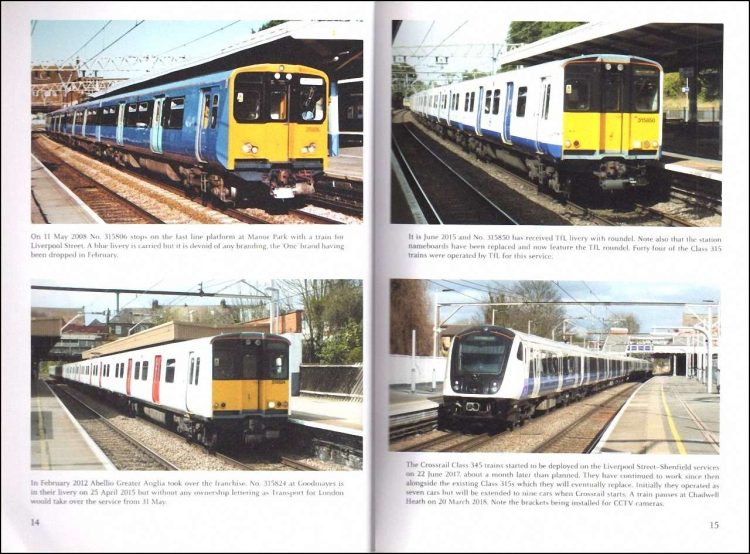
Although the book’s title is East London Railways, the pages below show trains on the line from Liverpool Street to Chingford in Hertfordshire, which is in North London. The left-hand photos show trains at Northumberland Park whilst on the right-hand page the locations are Chingford and Cambridge Heath.
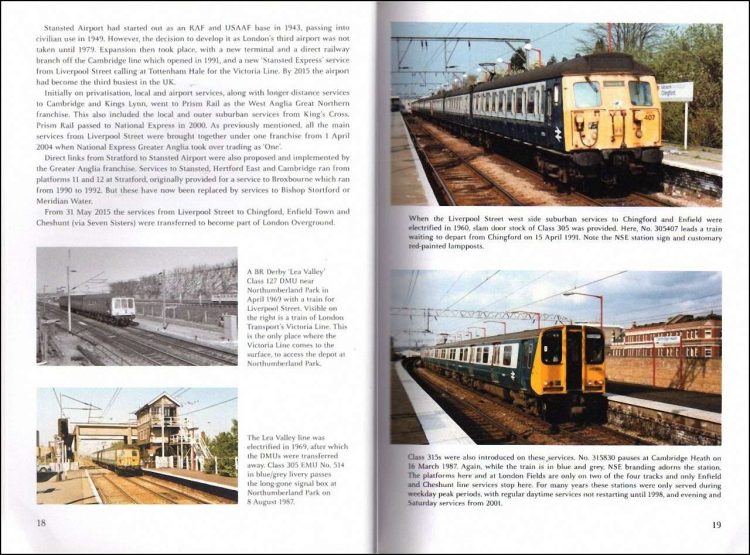
The heart of East London’s railways is probably the former London, Tilbury and Southend line from Fenchurch Street to Shoeburyness. Unfortunately, the book has very little coverage of the line, with the single page shown on the left below describing the line, and just a single paragraph describing the line’s history. A major omission is the absence of a photo of the line’s terminus at Fenchurch Street. The photo at the bottom-right shows one of the line’s electric multiple units at Chalkwell, which is a suburb of Southend-on-Sea and many miles from East London.
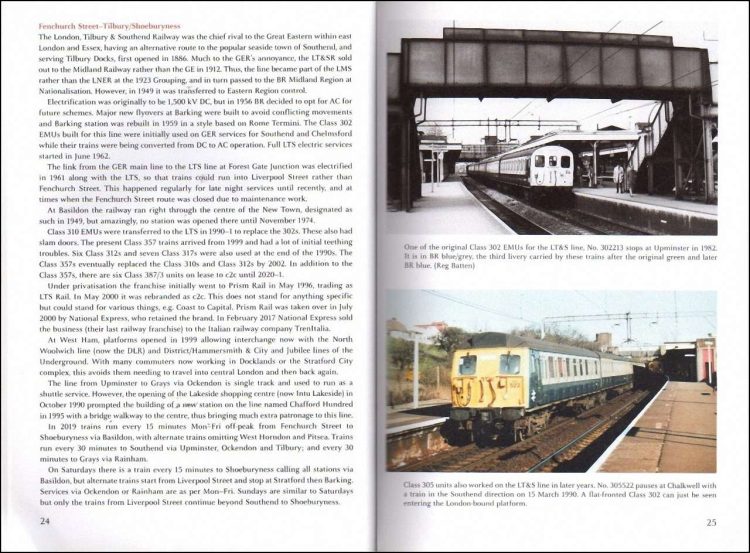
District line services run through East London to Barking, and the book includes several photos depicting trains on the route. However, although the book includes photos of District Line trains in East London, the ones on the left-hand page below are at locations in West London that are so far to the west they don’t feature in the book’s maps. At the top-right is a train at Stamford Brook and below it is a train at London Transport’s Acton Works.
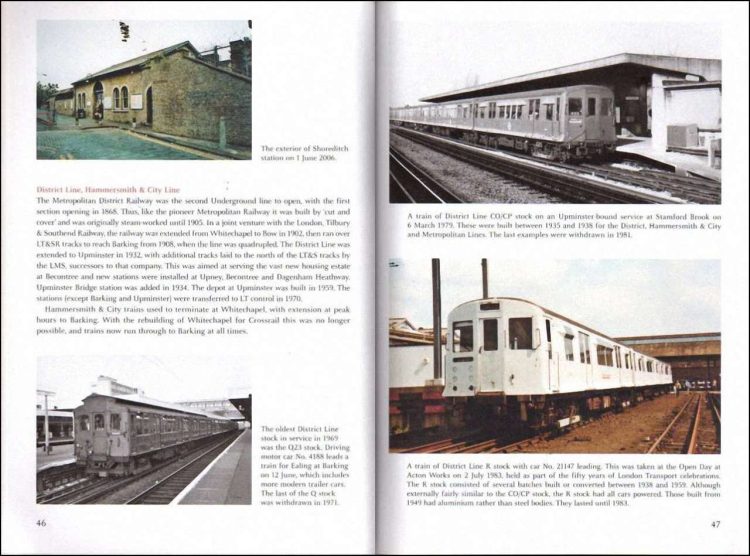
The book’s sub-title states From Docklands to Crossrail, and here the book fulfil sits promise with numerous photos of Crossrail under construction. However, the photo at the bottom-right is the only one in this section that shows a Crossrail train running, although another operational Crossrail train is illustrated in an earlier section depicting the Liverpool to Shenfield Line.
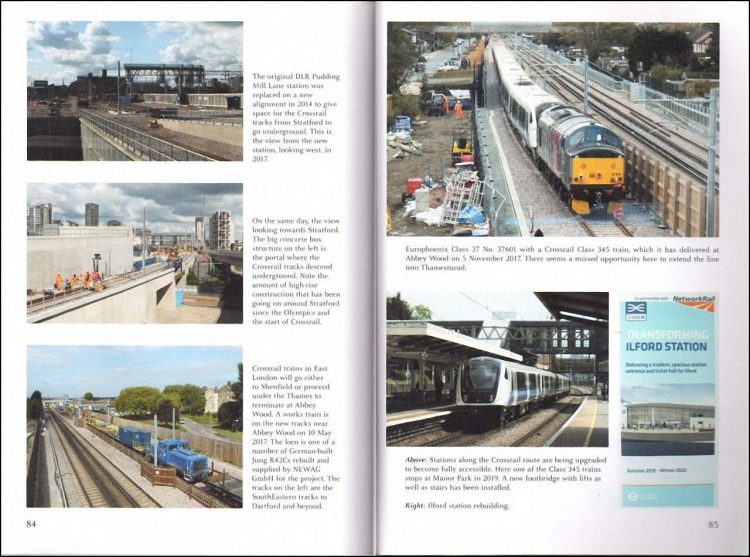
In summary, the book’s title promises an interesting tale of how railways in East London evolved from the myriad of lines serving the docks to the 21st century and the opening of Crossrail. Unfortunately, the title is very misleading. As well as railways in East London, the book includes coverage of lines through North London to Hertfordshire, and the Docklands in the title refers to the Docklands Light Railway. Although ships continued to serve London’s docks until 1981, there is not a single photo or reference to them. Passengers to East London have the option of travelling from Liverpool Street or Fenchurch Street, and while there is a section describing the rebuilding of Liverpool Street, the book lacks a single photograph of Fenchurch Street. There are also no photographs of the many freight trains that use the Great Eastern Main Line after joining it at Stratford, or of the locomotive-hauled expresses from Liverpool Street. Many of the photographs refer to features in the photos, but unfortunately the quality of reproduction makes those features very difficult or impossible to spot. For anyone who has a great interest in electric or diesel multiple units or underground trains on railways in the east of London they might find a place for this book on their bookshelf.
The book is available to purchase from Amazon for £10.99.
We would like to thank Amberley Publishing for providing RailAdvent with a copy of the book for review.






Responses